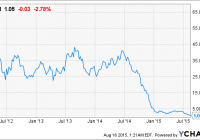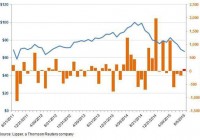Understanding XLE: Looking Back And Going Forward
XLE has outperformed oil thus far this year. This does not mean it will outperform oil in a bull market. Diversification is a strength to prevent weakness, but also limits potential investment upside. With oil prices nearing the $40 a barrel mark there are many enterprising investors hypothesizing that now is the time to hop into an Energy sector ETF and enjoy the ride if oil prices recover. Surely it makes sense that the Energy Select Sector SPDR ETF (NYSEARCA: XLE ) would increase along with oil prices; conventional wisdom would have an investor believe that with oil prices so low energy sector ETFs have massive upside. However, examining a few charts tells a far different story, that the very same diversification that limits its downside also restricts the fund’s upside. It has been noted elsewhere on the site that the diversification of the ETF (as it sets out to track the Energy industry as a whole) allows it to outperform the The United States Oil ETF (NYSEARCA: USO ). While this may be true over the past five years, in which XLE has gained 30% despite USO dropping over 58% (all figures at time of writing), it is a fundamentally misguided belief to assume this would occur in an oil recovery. Because, as the chart below shows, the 5 year comparison began at a high-point in the commodity cycle, meaning USO could only really remain flat and then fall drastically in accordance with the WTI collapse; conversely, during a generally flat market with high oil prices the Energy ETF had room to grow along with the Earnings of the companies it tracked. (click to enlarge) What is worth noting, however, is that XLE has not seen nearly as severely a sell off as Crude Oil or the ETFs that track it. Could this mean XLE is the perfect instrument for every portfolio ? Just looking at the five-year chart and other analysis on the fund would have you believe it is, but it makes the crucial mistake of not recognizing how the companies composing XLE will perform in the future, and how its composition limits returns the same way it limits downside. Before proceeding, I highly recommend an investor read Jonathan Prather’s article on XLE, as it does a fantastic job of depicting the fund’s correlation with the index it tracks and why it is a better investment than its peers. There is one issue to be noted with the article, however, and that is with the assertion that “It is clear that XLE is more capable of mitigating its downside in a weak environment whilst maximizing returns in a bull market. I believe companies are able to develop strategies that allow for protection from fluctuations in price.” From March 15 to May 28 USO drastically outperformed XLE in a bull market; it is in a rising commodity price environment that USO will dominate XLE, thus any investor interested in an ETF to play the recovery could see higher returns in USO, not XLE. As Prather noted, though, XLE offers more downside protection, or at least has thus far. Now, to understand why XLE has managed the downturn without tumbling nearly as far as oil itself we need to examine its holdings and analyze what they might mean for the future — in both a low oil pricing environment and in a rising one, before judging whether or not to invest. How XLE Has Thus Far Outperformed Oil In the case of a severe downturn it is the diversification of the fund that gives it its strength, as noted above. The mechanics behind this result from the companies in the downstream performing exceptionally well and benefiting from lower oil prices, thus the share price gain from the refining stocks — which comprise about 12% of the overall fund — has mitigated the more drastic falls in some of the Exploration and Production companies. The chart below depicts just how well refiners have performed, demonstrating that their appreciation has helped keep XLE from sinking to the same depths as USO: (click to enlarge) But because of this paradigm the idea that the refiners will grow XLE is slightly misguided; that is, because they are only a portion of the pie they will not propel the entire fund in the green if other components continue to falter. Overall, refiners may be loss limiting in a low-oil price environment, but they are not gain-leading. An investor operating under the belief that oil prices are to remain lower for longer best not seek XLE for its refiners, a pure refiner-play would, of course, be the better bet. Moreover, while some of the fund’s Offshore Drillers and Shale Producers have particularly felt the pain of oil’s fall, many producers have had their costs reduced or managed the commodities market well enough to outperform the general oil market (in the case of Cabot Oil and Gas and EOG Resources , for example). The below chart depicts how some of the E&Ps have performed over the past six months, with USO in bold: (click to enlarge) Clearly many of the fund’s E&Ps, which account for around 32% of total fund investments, have exceeded oil’s own performance, as — for many — reduced costs, focuses on core acreage, and advances in technology have led to higher returns for this resilient group. Of course, an investor would have been far worse handpicking an E&P over XLE, as some such as Chesapeake Energy (NYSE: CHK ) — now down 63% over the past six months — have underperformed even oil itself. The same paradigm holds true for the fund’s other groups, with ExxonMobil (NYSE: XOM ) down just 15% over the past six months (versus 25% for USO); moreover, Williams Companies (NYSE: WMB ) is 6% in the green over the same time period due partially to their large natural gas exposure. Many of the services companies, such as Schlumberger (NYSE: SLB ) and Halliburton (NYSE: HAL ), have shed less than 10% of their value since January as their businesses are not nearly as oil-dependent as the E&Ps. Due to its diversification across sectors that have varying degrees of oil dependency — and across companies within these sectors — XLE’s downside has been limited enough to prevent severe losses. However, before making any investment decision we must understand how this knowledge will manifest itself in future price movements. Going Forward What happens if oil truly remains lower for longer? For USO, that means the downside is likely limited to another 5 to 10% if we see $35 a barrel oil, and if oil stagnates around $40 a barrel USO is unlikely to lose more than 4% of its value. Conversely, XLE has far more room to trend lower in a stagnating low price environment, just as it could outperform a flat, high price oil market for years. That is, as oil prices remain lower for longer the Integrated Companies and E&Ps will shed more and more value, as oil remains flat (and, by extension, USO minus fees). Although XLE may still be better than an individual E&P play in this scenario, the fund’s large dependency on these two segments will send it lower than the 4% maximum loss USO will experience with oil stagnating in the $39-42 range. One of the best shale producers, EOG Resources (representing approximately 4% of XLE’s total investments), even noted that they will not take steps to grow production until oil fully recovers. Thus at this point in time the downside of XLE may exceed the downside of oil itself, in spite of the refiners, pipeline companies, and service companies that partially make up the fund. An investor may be thinking “that’s great, but earlier the idea was that XLE could outperform in a bull market, isn’t that at least true?” Not quite, as the same varying degrees of oil dependence and uniqueness of companies within the fund limit returns the same way they limited weakness. This manifested itself between March 14, 2015 and May 28, 2015 as USO gained 20% and XLE climbed less than 4% over the same period. (click to enlarge) If oil recovers to $50 a barrel then USO would appreciate almost 25%, that same type of performance seems highly unlikely out of XLE as many of the E&Ps need oil prices above $50 over the long-term. While the rally in E&Ps and in the Integrated companies would propel XLE modestly, its diversification would likely again limit returns as depicted in the chart above. Overall, XLE still limits its downside with diversification, but a current investment in it seems akin to catching the proverbial falling knife: the longer oil stays low, the longer its compositions (with exceptions in the downstream, of course) struggle. For a very conservative investor XLE may be the right choice for long-term buy and hold exposure to oil; however, for a trader looking to profit off of an uptick in oil prices XLE is hardly the vehicle to do it with. Disclosure: I am/we are long BP. (More…) I wrote this article myself, and it expresses my own opinions. I am not receiving compensation for it (other than from Seeking Alpha). I have no business relationship with any company whose stock is mentioned in this article.

